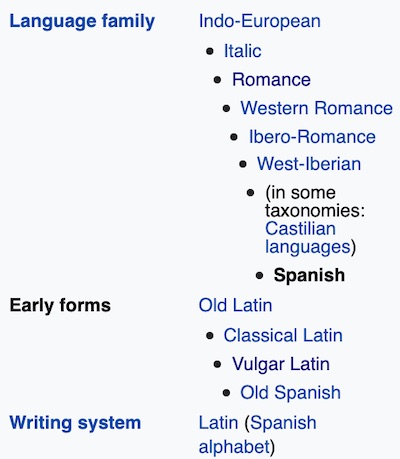Spanish is spoken by around 550 million people around the world, and it an official language in about 20 countries. Most of these countries are in Latin America. With around 480million native speakers, Spanish is the second most spoken native language. 1 One of the common questions from potential students is which Spanish should someone learn. We are discussing here the significant differences in the language spoken in different parts of the world, especially between Spanish used in Latin America and Spain (Castilian Spanish). We hope to help you to make a decision on which Spanish you should be looking to learn.
Spanish Language – History
The Spanish language evolved from Vulgar Latin beginning in 210 BCE. And the written standard for the language was developed between the 13th to 16th centuries in cities like Toledo and Madrid. See the language family and evolution below.

Spanish was taken to America and Spanish East Indies (the Philippines and Taiwan, etc.) during Spanish colonization from 16th Century 2. While the Spanish language continued to evolve in Spain, Latin American Spanish also changed and absorbed words from English and local languages.
Differences between Latin American Spanish and Spanish in Spain
Like other languages, due to adaptation to the local culture and other regional languages present, Spanish have difference across various geographical areas. Let us look at these differences broadly to see if they are significant enough to impact your decision to learn one type of the other.
Spanish Alphabets
The Spanish language is written using the Spanish Alphabet, which is the same as the English Alphabet (the Latin script) with one additional letter “ñ”3. Some of the compound letters were dropped earlier and re-instated later in Latin American Spanish. They still use compound letters such as “ch”. Thus you will see more letters (about 30) in Latin American Spanish.
Pronunciation
There are differences in pronunciation between Spanish in different parts of the world. The major difference is in the pronunciation of the letter c and z.
Vocabulary
Latin American Spanish has a lot more local and English words added to the vocabulary since language is used in a wider geographical area. For example, “computer” is “ordenador” in Castilian Spanish but “computadora” in Latin American Spanish. Some words have a different meanings in different countries.
Grammar
There are slight differences in grammar between the versions of Spanish. For example, use of the 2nd person personal pronouns (in English “you” is used for singular and plural). Countries like Argentina Uruguay and Paraguay use el ” voseo”, vos instead of tú (you).
Conclusion
If you are planning to appear for DELE 4(most common certification examination for Spanish) examination, you have to prepare in Spanish from Spain. Similarly, if you plan to use the language in Latin America or in the USA, then obviously your choice will be Latin American Spanish. Most of the academic texts suggested for IB, IGGCSE curriculum is based on Castilian, whereas Spanish AP books for the US curriculum is based on Latin American Spanish.
As the differences are not very significant and manageable to learn/unlearn based on the requirement, these differences should not stop you from learning Spanish readily available to you. You can always learn the extra bit and will be able to manage similarly to someone who can easily manage the US English, UK English or Australian English.
Classvio has teachers who can teach Latin American Spanish as well as Spanish from Spain. You can signup to attend a free trial class and understand more about different Spanish types.

